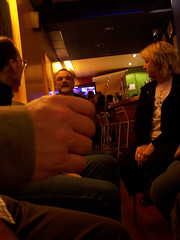Come the End of the World, I suspect the sky might look a little like it did this evening…

(more images)
Tag: photos
Was I really in Barcelona last week?
We only got back from Barcelona 3 days ago and already it seems more like it was 3 weeks ago. There’s nothing like 400 unread emails in your inbox to make you forget about what you were doing the week before!!!
For those of you who enjoy looking at holiday photographs, there’s nearly 400 of mine on Flickr, or you can find all the conference photos here. Tim from Birkbeck has also been adding Barcelona photos to Flickr. Tim’s head also appears in this serendipity photograph taken late on the Wednesday evening in a random bar — someone’s (maybe Chris from Lincoln?) hand got in the way and I can almost here a voice saying “I will crush you!” in the background 😀

The 4 presentations I took part in are available at: https://library.hud.ac.uk/barcelona
The list of Library 2.0 examples used in the Web 2.0 session is:
- Ball State University, Indiana (student blogs)
- La Crosse Public Library, Wisconsin (instant messaging widget)
- University of Alberta Libraries, Canada (RSS feeds)
- Westmont Public Library, Illinois (Flickr)
- Stevens County Rural Library, Washington (wiki)
- University of Huddersfield, UK (electronic resources wiki)
- Biblioteksvar, Norway (IM and SMS reference)
- Thomas Ford Memorial Library, Illinois (blog for local history)
- Thomas Ford Memorial Library, Illinois (Flickr and gaming evenings)
- University of Worcester, UK (library blog)
- Dowling College Library, New York (podcasts)
- Cheshire Public Library, Connecticut (podcasts)
- Charlotte & Mecklenburg County Public Library (Learning 2.0 staff programme)
- Glasgow University Library (podcasts)
- Hartlepool Borough Council Libraries (podcasts)
- University of Northampton Library (library blog)
- Topeka & Shawnee County Public Library, Kansas (MySpace)
- Topeka & Shawnee County Public Library, Kansas (library blog)
- McCracken County Public Library, Kentucky (YouTube)
- St. Joseph County Public Library, Indiana (YouTube)
- Ann Arbor District Library, Michigan (library blog and a whole lot more!)
- Info Island (Second Life)
- Virtual librariesinteract.info (Second Life)
- Library Success Wiki
- Library 2.0 Community at ning.com
…phew — hopefully there was something of interest in that little lot! I’m sure were at least a hundred more examples I could have included and, if you’ve got a good one, please post a comment with the details 🙂
The plan is to gather together all of the presentations from the conference and add them to the wiki. It’s currently branded the “Dynix User Group UK” wiki but, once the various European User Groups start to come together, I’m sure it will get a more generic title — I quite like SLUG (SirsiDynix Libraries User Group), although that’s quite similar to SMUG (SFX & MetaLib User Group).
Don’t forget, if you’re a SirsiDynix library in the north of England (Unicorn, Dynix, or Horizon), there’s a meeting at the University of Bradford on May 17th. A trip to the (in)famous Kashmir Restaurant for a curry is on the cards for those who attend 🙂
Barcelona – DUG/EUUG 2007
Bryony and I have been in Barcelona now for just over 24 hours and my feet are already knackered from all the walking we’ve done!
The joint DUG/EUUG SirsiDynix Conference starts on Wednesday, but we decided to fly out for a few days of sightseeing in advance.
A few of the photos from today and yesterday are on Flickr, although I haven’t finished tagging and adding descriptions yet…











OPAC Survey results – part 8
Library and Information Show 2007
I’ve just about recovered from LiS 2007 and hopefully I didn’t cram too much into the 30 minutes I had for my session!
There’s a few photos from the event on Flickr…






OPAC Survey
I think the previous post will be the last batch of graphs unless I uncover something new in the data. Instead, many thanks to my colleague Lisa (Senior Assistant Librarian for Applied Sciences and Computing & Engineering) for sifting through the respondent comments for the common themes. The full figures will be in the report, but here’s a snifter of the “feature comments”…
The most common wanted feature was federated searching (both electronic resources and other libraries’ holdings), with over 30 responses.
Next up, being able to customise the OPAC (look & feel and adding new features), with over 15 comments.
Relevancy ranking was specifically mentioned by at least 10 respondents, with 9 wanting personal borrowing histories, Amazon style wish lists, and saved session results.
1 respondent wanted to be able to search by colour of cover and another wanted wiki style functionality adding to the OPAC.
For the “final comments” section, here’s a sample…
10 respondents felt that “2.0” style features could be a distraction and that the OPAC should be kept simple. Another 10 said that lack of staff expertise or money was stopping them from being able to make the changes they would like to their OPACs.
However, the most common theme was laying the blame squarely at the feet of the vendors — broken promises, slowness of feature delivery, etc.
Lisa also picked out a handful of the comments that she felt stood out and here’s just 3 of them…
It seems that OPACs are too busy trying to please every customer. They spend too much time developing and not nearly enough time releasing software. The ability of the library to customize the OPAC should be the primary feature. Developing extensive APIs and building in flexibility should be at the top of the list for development. Let librarians develop the specific tools they want or need. Allow librarians to create add-ons and templates and distribute them to other libraries. OPAC vendors need to concentrate on search technology and not the next great feature.
I think we should always keep in mind the key aim of the OPAC is so users can locate/access resources. These new web 2.0 type enhancements can be fantastic, but there is a danger in using them just because we think we should.
We took a risk in 2002 and extensively customized our OPAC outside the confines of vendor support. Our efforts have been extremely successful and it has essentially become our new model for the direction we’re heading in the future. We’ll be doing MORE customization and application development in the future, rather than less. We’re much more likely now to move away from traditional library automation vendors as we consider what comes next.
(Phil Feilmeyer, Hennepin County Library)